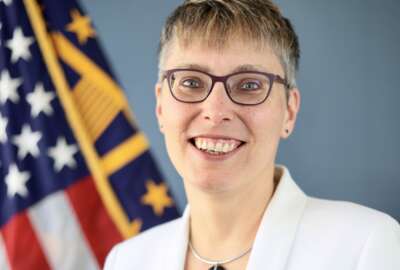
Contractors just want federal business to continue normally
When it comes to IT, spending priorities contractors can expect from the Biden administration will look familiar. We got highlights of Bloomberg Government's list...
Best listening experience is on Chrome, Firefox or Safari. Subscribe to Federal Drive’s daily audio interviews on Apple Podcasts or PodcastOne.
When it comes to information technology, the spending priorities contractors can expect from the Biden administration will look familiar. It’s not as if artificial intelligence or cloud computing are going away. Federal Drive with Tom Temin got highlights of its list of ten markets to watch from Bloomberg Government federal market analyst Laura Criste.
Interview transcript:
Tom Temin: Laura, good to have you back.
Laura Criste: Thanks for having me.
Tom Temin: Alright. So you put them in alphabetical order instead of size order. But what will be the spending priorities? I mentioned, artificial intelligence and cloud, because those are the first two on the alphabetical list. But it does look like kind of a familiar list.
Laura Criste: It’s a pretty familiar list. And I’ve been doing this for about three years, this 10 markets to watch slide deck, and they’re often pretty similar, especially in the IT space. I would say what’s a little bit different is we’re probably going to see an even bigger emphasis on shared services. So that was on there previously, but the Biden administration is emphasizing shared services. President Biden put out requests for $10 billion for IT modernization, and talked a lot about shared services for cloud and cybersecurity in that. So familiar things, but maybe a little bit more money going toward it. AI, I always in the last couple years have said that AI is going to be one of the biggest priorities because we keep seeing it pop up. This is the same for cloud and cybersecurity too really. We see them pop up in things that aren’t necessarily artificial intelligence solicitations, right. So we’re seeing it in solicitations that are for something else, but they want artificial intelligence included, or at least thought about. So cybersecurity and cloud come up in a similar way. I would love to mention that’s a little different this year is that we don’t have cybersecurity in the top 10 markets, I did include it in the back because I couldn’t not talk about it at all. But cybersecurity spending did dip a little bit from fiscal 19 to 20. And I didn’t want to include something that decreased from 2019 to 2020. But I still do expect it to be an important market and something that clients and government contractors in general want to think about.
Tom Temin: Sure, that’s how the solar winds are blowing, I guess you might. And one of the areas you mentioned is supply chain. And since we’re talking about acquisitions and purchase levels, what do you mean by supply chain as a market to watch?
Laura Criste: So one thing I should mention is that my entire team worked on this, I wasn’t the only one. And we all kind of pitched in to talk about the markets that we are the experts in. So IT is more my swim lane, but I can still talk a little bit about supply chain, because there is a little bit of an IT angle there. My colleague Rob Levinson put that one together. So I just kind of want to give a shout out to them. So by supply chain in this one in particular, I think the entire supply chain type things are included. I believe that we don’t have every tiny little, you know, truck that’s going to move something from one place to another. But it’s more logistics, there’s a big focus on that one on DoD, rather than supply chain management is not what we’re talking about here. We’re talking about supply chain management, and some of the movement of things as well.
Tom Temin: Okay, and we’ll have to get Rob on, he’s a regular here too. And the other thing you focus on the chosen real big growth between 19 and 20, and presumably will grow unless Congress gets antsy about it, and that is other transaction authority.
Laura Criste: As a team we’ve been covering a lot in the last few years because of the huge amount of use and the growth of use. And I think the most interesting thing to me in the last year was that HHS started using OTAs a lot more because of kind of their response to COVID and because OTAs are so much easier and quicker to award. So I think that because they used OTAs a lot more in the last year, probably not as much response to COVID and not needing to respond to things quite as quickly this year, I still think they might use it more, because they’ve probably seen the benefit of it. So we do project a huge amount of growth again. We’ve kind of seen what almost looks like exponential growth, probably not quite that, but it has increased quite quickly in the last couple years and we expect that to continue.
Tom Temin: Well it more than doubled last year, so if that keeps going, then that becomes exponential I guess. And could the increasing use of OTA not simply be because it’s easy to award but because there really is the acquisition of prototypes for innovative things that the government has been talking about that it says it needs?
Laura Criste: For sure. And I think the Defense Department has been the main agency using OTAs in recent years, but it’s not like they’re the only ones that need to prototype things. So I do think that other agencies could see that the Defense Department is using this for prototypes and that it’s going well, and they could maybe start using it as well. So that’s another reason why we’re kind of thinking maybe it could grow a large amount again in the future.
Tom Temin: And should the Biden administration convince Congress and there’s a better than even chance that he could, that there should be another $9 billion added to the Technology Modernization Fund? Which compared to $9 billion, it’s basically been zero. How would that affect the market and where might some of that spending go? Have you thought about that one yet?
Laura Criste: Yeah, I thought about that one a little bit. I personally would be very surprised if Congress actually appropriated that amount of money for the TMF, just because in the past large amounts of money have been requested and they’ve only received pennies in comparison. So I don’t really expect it. I haven’t seen it as much coming from the president, though, so I think that could be interesting to see what happens there if the TMF gets it. I did write about it, I don’t know couple weeks ago, and so I do think that a lot of the money would go toward shared services, a lot of the money would go towards cybersecurity. In the past, it’s been focused on digital services, and just a couple agencies, the money that has gone to the TMF. And I think that they would be able to expand and do a little bit more, or a lot more kind of innovative riskier projects because right now I think that the technology modernization board has been a little bit scared, I think, this is my read on it, to award things quickly because they want to see the return on investment, they want to get that money back in the fund so that they don’t deplete it. Because if the money goes away, the whole purpose is to be able to kind of replenish the fund as time goes on and then you can come up with new projects. The agencies get the money, they save money, they give the money back to the fund, new projects are awarded, you can do that a lot more quickly with $9 billion then you can with 250 million, or whatever they have exactly in the fund. So they can have it riskier, if some things don’t work out, they fail, they don’t pay the fund back, there’s still a ton more money to be able to go into new projects in IT modernization.
Tom Temin: And you mentioned digital services, that’s a word that has been around now for some time. And it seems related to modernization because one of the goals of modernization is to have better digital services, better online service to citizens. Where do you see that going in the coming year?
Laura Criste: So that was one of our markets to watch as well because that one has grown reasonably quickly as well, up 7% from 2016 to 2020. And we saw a lot of digital services increases around kind of citizen facing things, websites for veterans and for Medicare and Medicaid, those types of projects. And we also in the last couple years got a law called 21st Century Idea. Agencies are still implementing that. My expectation based on the last couple FITARA scorecards is that that’s going to be a lot more important for reporting in the future. So hopefully, agencies will kind of continue making websites and forums easier to use. With COVID, I think this becomes even more important and agencies will see that interacting with the government online can reduce the need to meet in person and kind of reduce the risk of spreading COVID. So maybe that becomes less important, but I think they’ll see the benefit of kind of being able to speed things up and spend less time face to face and more time quickly getting through forms and the types of things that they need to interact with people for.
Tom Temin: So what’s your best advice for IT contractors to kind of position themselves for what you see ahead?
Laura Criste: So that’s a hard question I think because there’s so many different types of IT contractors. I think that what we’re seeing is that a lot of the types of IT that you’ve seen growing in the past, so cybersecurity, digital services, cloud, AI, shared services, all of those are going to continue to grow. So if contractors are doing those things, keep working on that, keep trying to innovate and incorporate emerging technologies into your products and services if you can. I don’t think there’s going to be anything totally new.
Tom Temin: Let’s just get a budget passed so people can go on with it.
Laura Criste: Yep, exactly. And if we can get more of that money in IT modernization, if you can show that your services can be implemented across different agencies, I think you’re going to be in really good shape.
Tom Temin: Laura Criste is a federal market analyst with Bloomberg Government. As always, thanks so much.
Laura Criste: Thank you.
Copyright © 2025 Federal News Network. All rights reserved. This website is not intended for users located within the European Economic Area.
Tom Temin is host of the Federal Drive and has been providing insight on federal technology and management issues for more than 30 years.
Follow @tteminWFED
Related Stories

DoD’s JAIC rolling out new contracts to speed up AI acquisition




